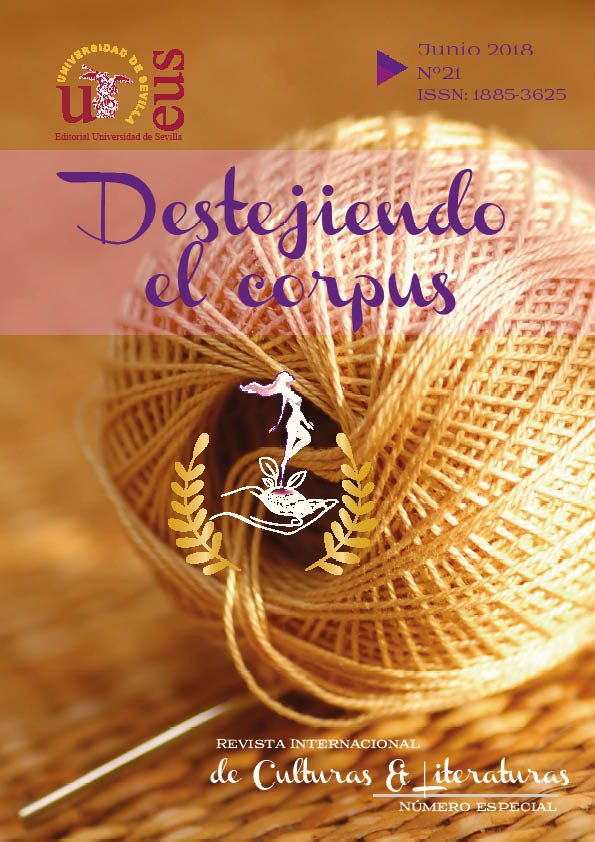MEDUSA, EVA AND COATLICUE IN THE EUROPEAN IMAGINARY SINCE THE CENTURIES OF THE CONQUEST
DOI:
https://doi.org/10.12795/ricl.v0i21.4784Keywords:
imaginario colonial, educación pública, mujeres serpiente, emociones negativasAbstract
The existing alliance within the Western tradition between myths and stereotypes about the feminine demands the examination of some of the emotional consequences of that masculine and colonial gaze, which annihilated the Aztec civilization. The invention of serpent women inspired the most devastating public myths of Medusa and Eve, theorizing and shaping (serpent and homicidal gaze) otherness from ancient times to the 16th century and beyond. The analysis focuses on the pragmatic uses of the imaginary of female alterity and its repercussion on other cultures, through the example of the Aztec goddess Coatlicue.
Downloads
References
Adorno, T. W. (et al.), La personalidad autoritaria. Buenos Aires, Proyección,1965.
Anzaldúa, G., Borderlands/La Frontera: The New Mestiza, San Francisco, Spinsters, Aunt Luke,1987.
Behar, R., “Sex and Sin, Witchcraft and the Devil in Late-Colonial Mexico”. American Ethnologist, vol.14 (1987), pp. 34-53.
Behar, R., Sexuality and Marriage in Colonial Spanish America, University of Nebraska Press,1989.
Carmack, R., Gasco J., Gossen, G., Legacy of Mesoamerica. The history and Culture of a Native American Civilization, New Jersey, Prentice Hall, 1996.
Dundes, A., The evil eye. A case Book, New York, Garland Pub., 1981.
Eco, U., Historia de la fealdad, Barcelona, Lumen, 2007.
Durand, G., Champs de l’imaginaire. (Textes réunis par D. Chauvin). Grenoble, Ellug, 1996.
Durand, G., Les structures anthropologiques de l’imaginaire, Paris, P.U.F., 1960.
Franco, J., “The Return of Coatlicue: Mexican Nationalism and the Aztec Past”. Journal of Latin American Cultural Studies, vol. 13 (2004), pp. 205-219.
Frazer, J. G., La rama dorada. Estudios sobre magia y religión, (Nueva edición a partir de la versión original en 12 vols.), México, Fondo de Cultura Económica, 2011, Vol. II, p.314 y p.838 .
Florez, F., “El Mal de Ojo de la etnografía clásica y la limpia posmoderna. Una apostilla a partir de la antropología de L. G. Vasco”. Tábula rasa, 2 (2004), pp. 23-46.
Freud, S., “La cabeza de Medusa” en Obras completas, Vol. 18, Barcelona, Biblioteca Nueva, 1992.
Fromm, E., Psicoanalisi e interpretazioni della società, (tr. it.) Turín, Loescher, 1977.
Fuentes, C., Introducción en El Diario de Frida Kahlo. Un íntimo autorretrato, México, Grupo Editorial Norma, 1995, pp.7-24.
Garcia, D. E., Nationalistic Iconography and Anti-iconology of the Aztec Coatlicue Sculpture, 2012. Internet. 10.7.2017. art.arizona.edu/.../Garcia, Dominique_Writing_Sample.pdf
Giallongo, A., La mujer serpiente. Historias de un enigma desde la antigüedad hasta el siglo XXI. Sevilla, Benilde, 2015.
Gómez Cano, G., El Regreso a Coatlicue: Diosas y Guerreras en el Folklore Mexicano. México, Xlibris Corporation, 2011.
Gramigna, A., Nahual. Ferrara, Stampa Universitaria Estense, 2013.
Klein, C. F., “The devil and the skirt an iconographic inquiry into the prehispanic nature of the Tzitzimime”, Ancient Mesoamerica,1, 2000, pp. 17-62. Internet. 10.1.2018.
Klein, C. F., “A New Interpretation of the Aztec Statue Called Catlike, “Snakes-HerSkirt”, Ethnohistory, 55, (2008) , pp. 230 -250.
Jung, C. G. y Von Franz, M.L., Man and his Symbols. New York, Dell Publishing Company, 1964.
Lacan, J., “Au-delà du “Principe de réalité” dans Écrits, Paris, Éditions du Seuil, 1996, pp.73-92.
Lanier Graham F., “Goddesses androgyny: Coatlicue of the Aztecs” in Monaghan, P., Goddesses in world culture, Australia and the Americas. Vol. III, Santa Barbara, Praeger, 2011, pp.6-76.
Levi,I.,“Medusa, the female genital and the Nazis”, 2003. Internet. 9.5.2017. <:www.reocities.com/psychohistory2001/ >
López Luján, L. “El ídolo sin pies ni cabeza. La Coatlicue a fines del siglo XVIII”, Estudios de cultura náthual. .42, (2011), pp. 203-232.
Lavrin, A., Sexuality and Marriage in Colonial Latin America, Lincoln, University of Nebraska Press, 1992, pp. 47-50.
Lawrence, D. H., La serpiente emplumada, Barcelona, Montesinos, 2014.
Martin, J.A., Los antagonismos de género y de clase en Morelos en Fowler- Salamini, H. y Vaughan, M. K., Mujeres del campo mexicano, 1850-1990. Zamora, El Colegio de Michoacán, Instituto de Ciencias Sociales y Humanidades, Benemérita Universidad de Puebla, 2003.
Matos Moctezuma, E., Las piedras negadas. De la Coatlicue al Templo Mayor, México: Consejo Nacional Para La Cultura y Las Artes, 1998.
Moller Okin, S., “Is Multiculturalism Bad for Women? “en Cohen J., Howard M. y Nussbaum M.C. Is Multiculturalism Bad for Women? Princeton, Princeton University Press, 1999, pp.7-24.
Parekh, B.., Rethinking Multiculturalism. Cultural Diversity and Political Theory, USA, Palgrave Macmillan, 2000.
Paz, O.,” Diosa, demonia, obra maestra. El arte de México: materia y sentido” en Obras Completas 7, Los privilegios de la vista II. Arte de México, México, Fondo de Cultura Económica, 2004, pp.75-88.
Taylor, Ch., A Secular Age, Harvard University Press, 2007.
Schreffler, M. J., “The Making of an Aztec Goddess: A Historiographic Study of the Coatlicue”, Thesis, Arizona State University, 1994.
Vernant, J. P., La mort dans les yeux. Figures de l’Autre en Grèce ancienne, Paris, Hachette, 1985.
Vernant, J. P., L’individu, la mort, l’amour. Soi-même et l’autre en Grèce ancienne, Paris, Gallimard, 1989.
Villa, A., Nezahualcóyotl. Poiesis e mito nell’educazione ancestrale náhuatl, Ferrara, Stampa Universitaria Estense, 2015.
Wilk, S., Medusa: Solving the Mystery of the Gorgo, New York, Oxford University Press, 2000.
Vespucio, A., Cuarta carta, “Mundus Novus” (1502). Internet. 13.11.2016. <http://pueblosoriginarios.com/textos/vespucio/vespucio.html>

